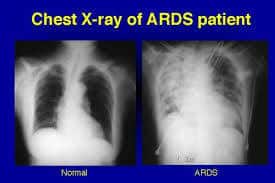CCRN ARDS
CCRN Adult Respiratory Distress Syndrome (ARDS) Overview
Acute respiratory distress syndrome (ARDS), previously known as respiratory distress syndrome (RDS), adult respiratory distress syndrome, or shock lung, is a medical condition occurring in critically ill patients characterized by widespread inflammation in the lungs. ARDS is not a particular disease, rather it is a clinical phenotype which may be triggered by various pathologies such as trauma, pneumonia and sepsis.
The hallmark of ARDS is diffuse injury to cells which form the alveolar barrier, surfactant dysfunction, activation of the innate immune response, and abnormal coagulation. In effect, ARDS results in impaired gas exchange within the lungs at the level of the microscopic alveoli.
The syndrome is associated with a high mortality rate between 20 and 50%. The mortality rate with ARDS varies widely based on severity, the patient’s age, and the presence of other underlying medical conditions.
Although the terminology of “adult respiratory distress syndrome” has at times been used to differentiate ARDS from “infant respiratory distress syndrome” in neonates, international consensus is that “acute respiratory distress syndrome” is the best moniker because ARDS can affect those of all ages.
Signs and Symptoms
The signs and symptoms of ARDS often begin within two hours of an inciting event, but can occur after 1–3 days. Signs and symptoms may include:
-
- Severe shortness of breath
- Labored and unusually rapid breathing
- Low blood pressure
- Confusion and extreme tiredness
Causes
The mechanical cause of ARDS is fluid leaked from the smallest blood vessels in the lungs into the tiny air sacs where blood is oxygenated. Normally, a protective membrane keeps this fluid in the vessels. Severe illness or injury, however, can cause inflammation that undermines the membrane’s integrity, leading to the fluid leakage of ARDS.
The most common underlying causes of ARDS include
- Sepsis
- Inhalation of harmful substances
- Severe pneumonia
- Head, chest or other major injury
- Trauma, lung contusion
- Multiple blood transfusions
Risk Factors
Most people who develop ARDS are already hospitalized for another condition, and many are critically ill. You’re especially at risk if you have a widespread infection in your bloodstream (sepsis).
People who have a history of chronic alcoholism are at higher risk of developing ARDS. They’re also more likely to die of ARDS.
Complications
ARDS is extremely serious, but thanks to improved treatments, more people are surviving it. However, many survivors end up with potentially serious — and sometimes lasting — complications, including:
- Scarring in the lungs (pulmonary fibrosis). Scarring and thickening of the tissue between the air sacs can occur within a few weeks of the onset of ARDS. This stiffens your lungs, making it even more difficult for oxygen to flow from the air sacs into your bloodstream.
- Collapsed lung (pneumothorax). In most ARDS cases, a breathing machine called a ventilator is used to increase oxygen in the body and force fluid out of the lungs. However, the pressure and air volume of the ventilator can force gas to go through a small hole in the very outside of a lung and cause that lung to collapse.
- Blood clots. Lying still in the hospital while you’re on a ventilator can increase your risk of developing blood clots, particularly in the deep veins in your legs. If a clot forms in your leg, a portion of it can break off and travel to one or both of your lungs (pulmonary embolism) — where it blocks blood flow.
- Infections. Because the ventilator is attached directly to a tube inserted in your windpipe, this makes it much easier for germs to infect and further injure your lungs.
- Abnormal lung function. Many people with ARDS recover most of their lung function within several months to two years, but others may have breathing problems for the rest of their lives. Even people who do will usually have shortness of breath and fatigue and may need supplemental oxygen at home for a few months.
- Memory, cognitive and emotional problems. Sedatives and low levels of oxygen in the blood can lead to memory loss and cognitive problems after ARDS. In some cases, the effects may lessen over time, but in others, the damage may be permanent. Most ARDS survivors also report going through a period of depression, which is treatable.
Diagnosis
There’s no specific test to identify ARDS. The diagnosis is based on the physical exam, chest X-ray and oxygen levels and by ruling out other diseases and conditions — for example, certain heart problems — that can produce similar symptoms.
Imaging
- Chest X-ray – looking for pulmonary edema
- Computerized tomography (CT)
Lab tests
- Arterial blood gas
- Sputum cultures
Cardiac tests
- Electrocardiogram
- Echocardiog
Treatments
- Admission to the ICU
- Antibiotics
- Blood cultures
- Mechanical ventilation
Critical Care Courses
Overview
- Elite Reviews Offers A Variety Of Online Courses That Will More Than Adequately Help Prepare The Critical Care Nurse To Pass The National Exam.
- Each Course Includes Continuing Education Credit and Sample Questions.
Continuing Education
- Each Of Our Online Courses Has Been Approved Continuing Education Contact Hours by the California Board of Nursing
- Login To Your Account In Order To Access The Course Completion Certificate Once The Course Is Complete.
CCRN Free Trial
- FREE Sample Lecture & Prep Questions
- Available For 24 Hrs After Registration
- Click Free Trial Link To Get Started – CCRN Free Trial
How It Works
How It Works
- First – Purchase The Course By Clicking On The Blue Add To Cart Button – You Will Then Be Prompted To Create A User Account.
- Second – After Creating An Account, All 3 Options (90, 120 or 150 Days) Will Be Listed. Select The Option You Desire And Delete The Other Two.
- Third – You Will Be Prompted To Pay For The Review Using PayPal – After Payment You Will Be Redirected Back To Your Account.
- Last – Click The Start Button Located Within Your Account To Begin The Program
- 150 Sample Questions
- Q & A With Rationales
- Approved For 5 CEU’s
- 90 Days Availability
- Cost $75.00
- 1250+ Sample Questions
- Q & A With Rationales
- Approved For 25 CEU’s
- 90 Days Availability
- Cost $200.00
CCRN Practice Questions Bundle
- 1350+ Sample Questions
- Q & A With Rationales
- Approved For 30 CEU’s
- 90 Days Availability
- Cost $225.00
CCRN Review Course
- Option 1
- Lectures & 1250+ Questions
- Approved For 35 CEU’s
- 90 Days Availability
- Cost $325.00
- Option 2
- Lectures & 2000+ Questions
- Approved For 40 CEU’s
- 90 Days Availability
- Cost $350.00
CCRN Review Course Bundle
- Option 3
- Lectures & 3000+ Questions
- Approved For 70 CEU’s
- 90 Days Availability
- Cost $375.00






